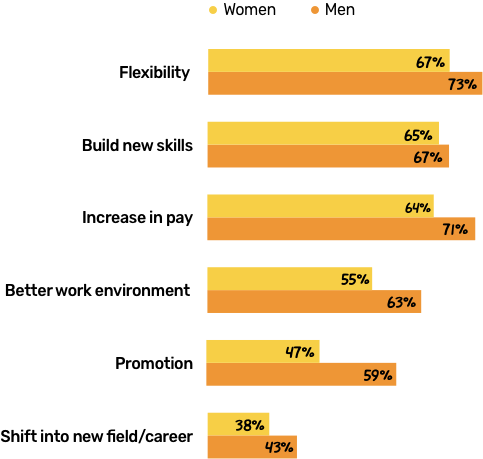Report
Improving internal mobility programs: How to win the talent war through internal recruitment

Research from Eagle Hill Consulting reveals that 54% of employees believe they have better job opportunities inside their current organizations. But this potential is untapped. Only 23% have actually been able to move into a new internal role. As organizations struggle to retain top talent, hiring from within is a renewed focus and priority. Yet internal mobility programs may not be designed to meet the needs of employees today. So how can organizations improve these programs to help employees learn, grow—and stay?
Why your best new hire might already work for you
A record 48 million Americans quit their jobs last year, according to the U.S. Department of Labor. Clearly, even in today’s uncertain economic environment, the Great Resignation is still a significant force. The number of people who left their jobs in January 2022 is not far from the record set in November 2021.
About half (49%) of employees we surveyed say higher pay is the top reason to find a new job, which has many looking outside their organization. After all, people who switch companies are more likely to get a salary bump than those who move to a new internal role, according to Pew Research Center. While more pay is a key motivator for job switching, people also want to do purposeful work. So much so that Gartner has dubbed the Great Resignation the Great Reflection. In the absence of higher pay, organizations should invest in creating more purposeful work for their employees so they feel fulfilled in their careers and motivated by what they see ahead. Internal mobility programs are key to doing this.
Supporting inside talent reduces outside pressures
Hiring from within through internal mobility programs can reduce costs and increase employee tenure and productivity. LinkedIn reports that employees at companies that make hiring from within a priority stay 41% longer than employees at organizations that don’t emphasize it. Despite these benefits, many organizations haven’t been focused on internal mobility programs in recent years. This is a 180-degree shift from the decades when pensions kept employees at the same company and filling openings with internal talent was common practice.
Employers today have a delicate balance to strike. They want to keep high performers while avoiding “golden handcuffs” situations where people stay so long that productivity and innovation suffer from ingrained ways of working and a lack of fresh ideas. To retain employees, organizations are rethinking benefits. In fact, Fortune reports that 51% of employees say that their organization has improved benefits packages in the last six months.
From the period following World War II to the 1970s, companies filled 90% of roles with internal personnel. Less than one-third do this today.
Source: Harvard Business Review
But here’s the reality. There’s no denying that benefits are important. But this, alone, will only go so far in helping organizations retain the employees they have now, especially high performers. Benefits are a great tool to draw in new talent, but they aren’t necessarily a tool to retain existing talent. Instead, organizations should identify and invest in programs that enable internal mobility, creating opportunities for employees to pursue new fields, take on leadership-level roles, and develop different skillsets. The goal? Giving employees a path to fulfill their personal and professional ambitions where they are.
Internal mobility isn’t new—it’s newly important
Internal mobility is employees’ movement into new opportunities within their current organization. It includes both vertical mobility (upward movement between job levels) and horizontal mobility (moving with the same job level). And it can take many forms.

Promotions

Formal career pathing

Succession planning

Transfers in the same department

Transfers in a different department

Job swaps

Stretch roles

Rotational programs
What’s stopping people from pursuing internal roles?
Understanding the employee perspective is fundamental to pinpoint why internal mobility programs haven’t been effective—and how to improve them moving forward. To explore this perspective, we surveyed more than 1,000 U.S. full-time employees across industries. Their responses reveal three challenges with internal mobility programs.
Internal roles aren’t instantly gratifying
Most employees have a positive view of internal mobility within their current organizations. In fact, more than half (54%) say they have better job opportunities inside their current organizations than outside. The majority believes that internal opportunities offer flexibility (70%), pay increases (68%), new skill building (66%), and a better work environment (59%) over the short term. Yet despite these positive perceptions, just 23% of employees have moved into a new internal role themselves, and about half (51%) know someone at the company who has. This gap between awareness and action could signal that the process of internal mobility itself is problematic in employees’ eyes. Consider the fact that 59% of them say that the opportunity to shift to a new field does not exist in the short term at their current organization. Internal mobility processes, while well understood, are time consuming and don’t fulfill employees’ desire to move quickly into a new role without internal red tape or frustrating complexity.

59% of employees
say that the opportunity to shift to a new field does not exist in the short term at their current organization.
Employees fear backlash for seeking new roles
Another reason that employees may be reluctant to seek a new role within the company is fear of backlash or alienation from their current manager or team, especially if they choose not to take the new role and continue working as they have. Even if companies encourage employees to seek out new roles in the company, it’s human nature that people might worry about the consequences, including how managers and co-workers perceive them and their commitment. In our survey, one in five employees say they are either somewhat or completely uncomfortable telling their direct managers that they want to explore other job options outside of their current role. Also, 35% feel there would be negative repercussions if they openly explored other job options. Younger workers (ages 18 to 34) are most likely to feel this way: 42% are concerned about negative repercussions.

35% of employees
feel there would be negative repercussions if they openly explored other job options

42% of employees
between the ages of 18 and 34 feel this way.
Women perceive opportunities and risks differently
There are striking differences in how the men and women we surveyed view internal mobility in their organizations. For one, women are less confident than men that better opportunities exist internally (50% vs. 57%). While almost the same percentage of women (76%) and men (75%) know what new internal roles are available to them, women are less confident in what new roles can deliver (Figure 1). They are also less likely to know the processes for moving into a new role (69% vs. 75%) and less comfortable telling their managers they are looking for one (73% vs. 84%). With organizations still feeling the effects of the pandemic exodus of women from the workforce, they must address these barriers in experience and perception to ensure women take full advantage of learning and advancement opportunities.
Figure 1: Women are less likely than men to believe internal opportunities can deliver opportunities for them
Question: In the short term, do you feel that the following job opportunities exist for you in your current organization?

Source: Eagle Hill Internal Mobility Survey 2022
Mobilizing internal mobility: How to get started

Create a mobility culture. The best internal mobility programs are grounded in an employee-first culture. Without it, organizations risk in-fighting among managers who hoard “their” employees instead of supporting their growth. This employee-first culture requires mindset and behavior shifts. Leaders must understand their role in advocating for employees’ growth. They should also make it a priority to regularly engage with employees on their long-term career goals, asking about what skills and capabilities they hope to be exposed to at work. As part of this, leaders should create a safe space for employees to speak up without fear and back their words with intention and actions. This helps employees know that employers are sincere, and that opportunities for internal advancement are real and achievable.

Remodel mobility programs. Most organizations don’t regularly assess how well their internal mobility programs are meeting the needs of their unique employee segments. With employee attitudes and expectations shifting all the time, it’s key to align programs with employee populations. For example, many organizations may not consider how employees’ needs for internal mobility may differ depending on their career stage (early stage vs. late stage). In addition, they may not consider how to design mobility programs so that regardless of identity, employees feel comfortable expressing and acting on their desire to be considered for such opportunities. As organizations review and refresh internal mobility programs and surrounding processes, organizations must also assess pay structures to make them as competitive as possible, so employees grow their salaries as they grow within the company.

Identify employees’ potential. Organizations often operate under the false assumption that they simply “don’t have the right talent” to fill roles internally. Leaders spend more time creating competencies that outline what skills employees demonstrate after they are in a role than they do analyzing people’s potential before they are in it. They never get a true picture of people’s talent potential. Instead, as Harvard Business Review explains, leaders should assess why certain employees are successful as a way to define high-potential employees in their organization. This view can be shared across departments so that leadership across the company is aware of how to identify potential and which employees are demonstrating clear potential for new challenges.

Remove opportunity barriers. It’s key to make it easy for employees to know what new roles and opportunities exist. Organizations should build processes that help employees take advantage of these things. This includes encouraging internal networking, speeding hiring procedures, and removing barriers to transitioning from one role to another. After all, employees want immediate change, which is more typically what they get when they move to another company. Organizations should also communicate the value proposition of an internal opportunity. Is it a raise? A new title? A bump in level? Or just more work? This information should be clear so that employees know they are investing their time in a sound opportunity that can fulfill their expectations.

Tell employees what you see in them. In the true spirit of internal mobility, leaders and managers should communicate more openly with employees about the potential they see in them. Leaders typically talk about their succession plans for high performers in isolation or very infrequently—only once or twice a year. With infrequent communication like this, leaders miss out on the opportunity to let employees know the organization sees them as valuable contributors—even future leaders. Without this feedback, employees could look for external opportunities simply because they don’t know how valued they are.
Investing in employees’ careers shouldn’t stop after they are hired. It’s about nurturing people’s goals and potential with the right opportunities for personal and professional growth. As organizations prioritize internal mobility programs to keep and grow their best talent, they should reevaluate their cultural norms and processes. They should consider their different employee populations, identifying the unique roadblocks and relevant incentive for each. Rebuilding internal mobility programs in ways that resonate with all employees is good for them. And it can deliver great benefits for the business—from better retention to higher productivity.
Methodology
The survey was conducted online by Ipsos the week of July 22 to 27, 2022. The survey included 1,140 respondents from a random sample of full-time employees across the United States. The survey polled respondents to understand what they are looking for in new roles and their views on internal mobility processes and opportunities in the organization they work for currently. The survey also included 300 interviews with local, state, and federal government workers.

